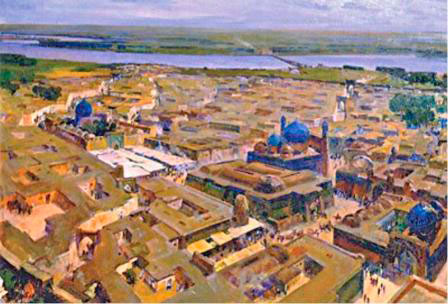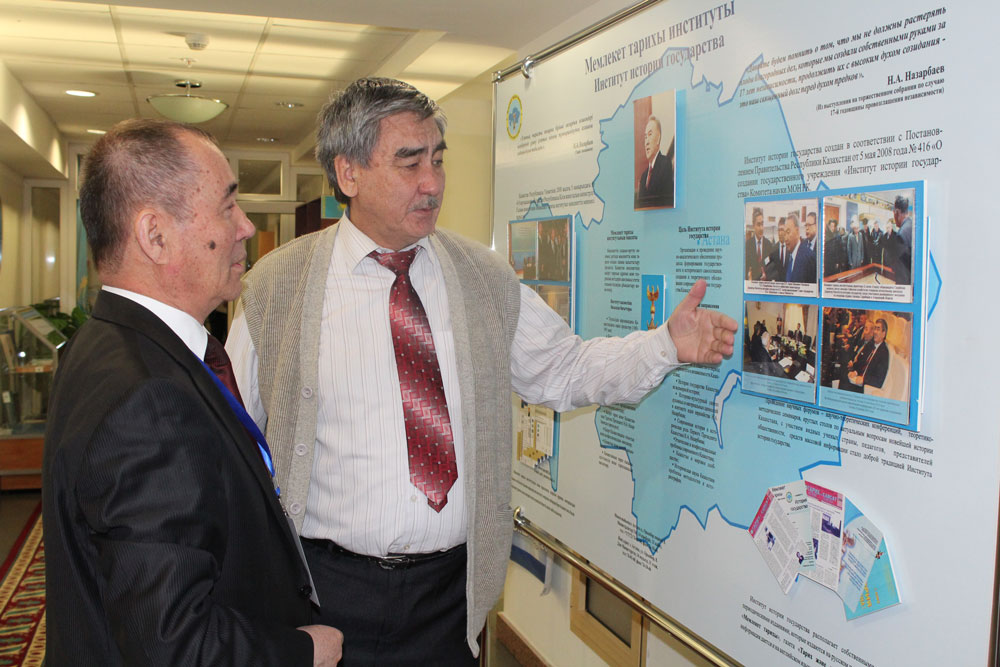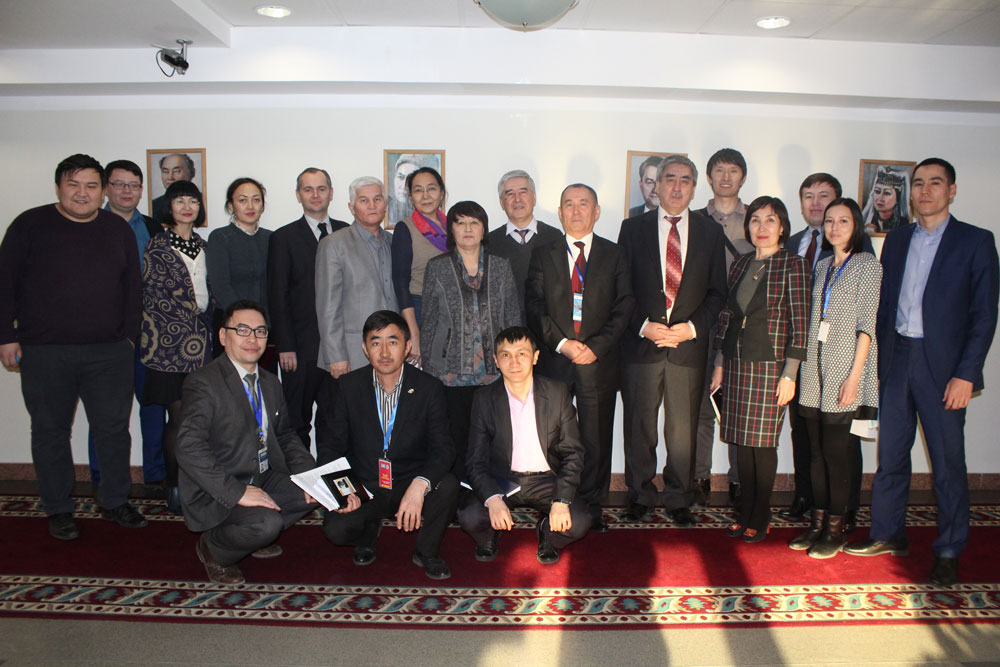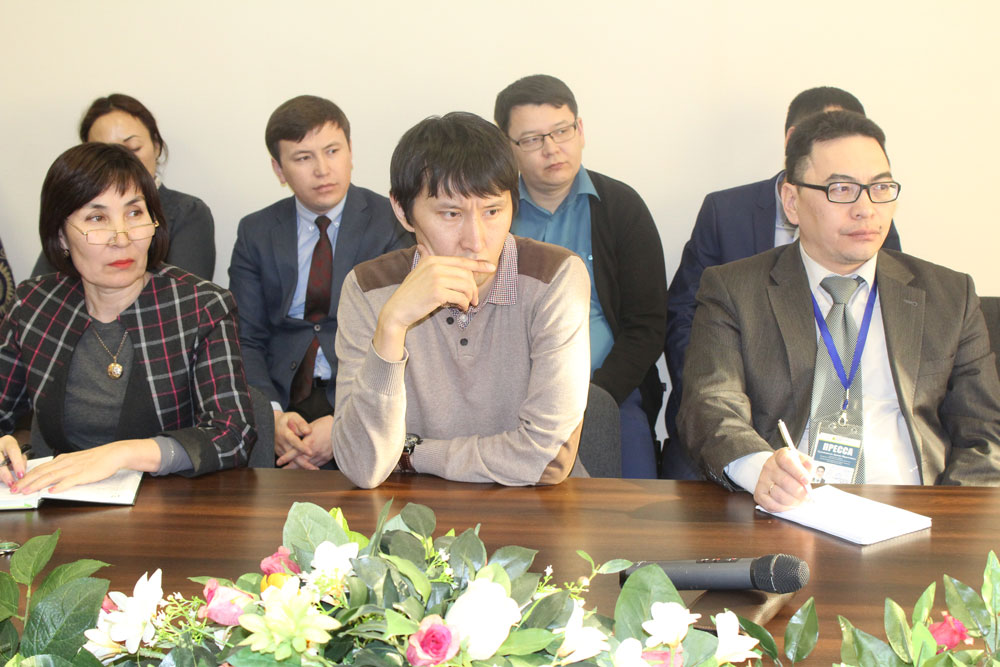
There is a sad kyui, which usually begins with the words: "When Khan Ormanbet died, when the tenfold Nogai Horde split, that's how mourned the separation Kazakhs and Nogais".
Ruzbikhan, emphasizing that the Shibanid state, the Kazakh Khanate and the Nogai Horde were formed on a single ethnic basis, wrote: "Three tribes are referred to Uzbeks, which are the most glorious in the domain of Genghis Khan. Now one [of them] - shibanites. The second tribe is the Kazakhs, who are glorious in the whole world by force and fearlessness, and the third tribe is mangyts."
The interest of Kazakh historians in the history of the Nogai people is not accidental, but natural. The history of Kazakhs and Nogais in the XV-XVI centuries in fact is the history of one people. Common origin, a single language, an identical economy, the absence of natural geographical boundaries and cultural barriers contributed not to isolation, but to close interaction and unrestricted connections between the steppe populations. And the current situation that arose after the collapse of the Soviet Union compels scientists to seek their roots, to the problem of self-identification.

Nogais are also known as mangyts - inhabitants of Nogai Horde, they called their state the Mangyt Yurt. The earliest references to the Nogai and the Nogai Horde are found in Turkish, Russian, Western European sources. The Nogai Horde was located on the territory of the left bank of the Lower Volga, the Southern Urals, Western and Central Kazakhstan, at the end of the XV-XVI century. It was one of the leading political forces of Eurasia.
The founder of the ruling dynasty in the Nogai Horde is the eminent figure of the Golden Horde Yedige, the actual ruler of the Ulus. After the death of Yedige in 1420, his son Gazi became the successor to the reign of the Mangyt Yurt, who distinguished himself by cruelty. In 1428 the emirs killed him and left the Horde. With the departure of the emirs and tribal chiefs to Siberia, the Mangyt Yurt declined. Yedige's sons and grandsons dispersed. The population migrated to the Uzbeks, then to Central Asia.
In the Mangyt Yurt, along with the youngest son of Yedige Nuraddin, only a small part of the nomads remained. Nuraddin's supremacy over the Mangyt Yurt caused sharp discontent from representatives of other eminent families.
The final formation of the Nogai Horde took place under the son of Nuraddin Vokkas. Vokkas was one of the main figures under Abulkhair Khan and even became his eldest emir. However, anticipating the weakening of the Uzbeks, in 1447 he separated from Abulkhair and returned to the Mangyt Yurt.

The Nogai Horde (the capital Saraychik) declared itself as an independent state by the beginning of the 16th century, having intensified in connection with the split of the Uzbek union. Then many of the tribes that used to be part of the Uzbek union joined the Nogai. "The Nogai Horde included tribes: mangkyts, noimans, kungarts, kypchaks, mins, toguchans, kolachs, alchins, chublaks, konklyks, keraits, kiyats and others."
During the disintegration of the Khanate of Abulkhair, Abbas, the son of Vokkas, along with the sons of Khadzhi-Mukhammed, played an active role in seizing the eastern possessions of Abulkhair at the mouth of the Syrdarya, the Amudarya and the upper Irtysh. In the XVI century the possession of the Mangyt beks bordered on the northwest with the Kazan Khanate along the rivers Samara, Kineli and Kinelchek. In the northeast, the Nogai Horde bordered on the Siberian Khanate. In the south, the Altai Mountains were a boundary line separating the Kazakh Khanate from the Nogai Horde. The eastern neighbors of the Nogai Horde were the Kazakh Khanate and Khanate of Central Asia.
Relations between Nogai and Kazakh dynasties also developed difficult, between them there were brutal wars. In the first quarter of the 16th century Kasym Khan conquered all the steppes beyond the Volga. The Uzbek states, for the most part, served as a refuge for refugees from the Nogai state, the Beks and Murzs, who had failed in the internecine struggle.
In the late 40's in the 16th century Yusup became the Nogai Bek. His attitude towards Russia was negative. Yusup planned a march to the Russian lands, but each time these plans were broken, often through the fault of Yusup’s brother Ismail, who sought positive relations with Russia. At the end of 1554 Yusup died, apparently not without the participation of his brother, and Bek became Ismail.
The death of Yusup was only the beginning of the calamities that struck the Nogai Horde. The war between Ismail and his nephews (Yusup's children) lasted several years and was characterized by unprecedented bitterness and death of a large number of nomads. Only in 1557 Ismail succeeded in finally establishing himself on the throne. To top it all off, a terrible famine and epidemics struck the Horde. As a result, the Nogai Horde could never achieve the power that it had before the confusion of the 1950s of XVI century. The flight of the Bek's subjects to the right - the Crimean - side of the Volga began. The split of the Nogai Horde resulted in the resettlement of part of the Nogai to the area of the Crimean Khanate.

Map of Muscovy by a traveler Gerberstein, 1549
20-30-ies of XVII century became the period of the last wave of migration of the population from the Nogai Horde to the Kazakh Khanate. "As a result of several waves of migrations of the 16th-17th centuries, the Nogai element was firmly entrenched in the Kazakh ethnos. The presence of this element was particularly noticeable in the west of Kazakhstan, where until the beginning of the 20th century the Nogai and Mangytai groups were preserved. The undoubted stimulus for assimilation was the fact that the junior zhuz was entirely located on the former territory of the Nogai Horde." Tynyshpaev wrote that "while the Kirghiz of the Elder Horde do not know the Golden Horde at all, and in the Middle Horde remember something only Kypchaks and Argyns, all legends and epics of the Alchyns speak only of the former life of the Golden Horde and the Nogai. That the Little Horde was part of the Nogai, this is beyond doubt."
The disintegration of the Nogai Horde into several parts practically broke the old social bonds linking the population of the two states. Cultural differentiation began. The Nogai Ulus, mostly roaming in the plains of the Northern Black Sea Region, that is, on a significant part of the territory of modern Romania, Moldova, Ukraine and southern Russia, found themselves in the orbit of influence of the Crimean Khanate and the Crimean Tatars.
In 1783, after the liquidation of the Crimean Khanate, the Russian authorities planned to relocate the Nogai in the in-between rivers of the Volga and the Urals. But the Nogai nobility, having decided that in this way they wanted to be exterminated, refused to leave the Kuban and raised an uprising that was brutally suppressed. The whole steppe between the Don and the Kuban deserted.
In the 50's of XIX century the majority of Russian Nogai moved to the Ottoman Empire. Since the sixties of the nineteenth century, the process of including Nogais in the legal and socioeconomic field of the Russian state was underway. In 1897 in the Russian Empire there were only about 64,000 Nogais, mostly residing in the Kuban, Terek, Dagestan and Stavropol provinces and everywhere constituted a small percentage of the population. For comparison, over 4 million were registered by Kazakhs for the same census, and they were the majority in the territory of Akmola, Semipalatinsk, Turgai, Ural, Syrdarya, Semirechye oblasts, and Mangyshlak county of the trans-Caspian region and Bukei Horde, which belongs to the Astrakhan province.
By the middle of the twentieth century, the Nogai were divided between the Karachaevo-Cherkessia, Chechen, Dagestan republics and the Stavropol territory.

Kidirniyazov Daniyal Saidahmedovich, Professor of the Dagestan Scientific Center of the Russian Academy of Sciences
Kidirniyazov Daniyal Saidahmedovich, Professor of the Dagestan Scientific Center of the Russian Academy of Sciences (Makhachkala, Russian Federation) is a well-known scientist and expert on the medieval history of the Nogai. D.S. Kidirniyazov is Doctor of Historical Sciences, a leading researcher at the Institute of History, Archeology and Ethnography of the Dagestan Scientific Center of the Russian Academy of Sciences, a specialist in the medieval history of the Nogai Horde, the North Caucasus and Dagestan, known in the North Caucasus. He passed from the post-graduate student of the Department of the pre-Soviet period of the Institute of History, Language and Literature of the Dagestan branch of the Academy of Sciences of the USSR to the leading researcher of the Department of Ancient and Medieval History of the Institute of the IAE of the Dagestan Scientific Center of the Russian Academy of Sciences, a professor in the specialty "Patriotic History".
Daniyal was born on October 5, 1952 in the village Kurdyukovskaya of the Shelkovsky district of the Chechen-Ingush ASSR and grew up in the Chechen-Ingush milieu. After graduation, he linked his life path with historical science. Being the son of the Nogai people, Daniyal Saidahmedovich devoted his life, his scientific works of the history of his people, who roamed in the Middle Ages on the Eurasian expanses, which left a notable mark in the history of Kazakhstan, Russia and Dagestan. Work on this topic allowed Daniyal Saidahmedovich in 2001 to defend his doctoral dissertation "Nogai in the XV-XVIII centuries. (Political, Economic and Cultural Aspects of Relations with Neighboring Countries and Peoples) ".
Among the scientific interests of Daniyal Saidahmedovich are not only the problems of the historical past of the Nogai people, but also a wide range of issues, of particular interest is the urgent and topical issue of the Caucasus today - the place, role and importance of Dagestan in the Caucasian policy of the three rival powers: the Ottoman Empire, Shah's Iran, then the Russian Empire in a difficult and fateful period for the peoples of Dagestan history.

D.S. Kidirniyazov with the director of the Institute of State History B.G. Ayagan (Astana)
The scientist actively participates in international scientific conferences, held both in Russia and in the post-Soviet republics. D.S. Kidirniyazov actively cooperates with foreign colleagues. Thanks to close ties with the Kazakh historian B.G. Ayagan (Astana) a meeting with a team of scientists from the Institute of the History of the State was held. Historians raised sharp questions about the Nogai history: why the Nogai Horde disintegrated, what were the relationships between the Nogai murz and the Kazakh khans and other issues. When asked about the difficulties Nogais experienced in studying their native language, the professor noted that the Nogai language is taught in the school in two versions: there is a Nogai language in the primary school and there is an optional study of the Nogai language.

Scientists were interested in the total number of Nogais. According to the professor, according to the official census, the Nogais make up 105 thousand people. Although in fact, their numbers are much larger. For example, in Crimea they are recorded as Crimean Tatars and there is a mercantile reason: Crimean Tatars receive certain subsidies from the state.
At present, the Nogais live compactly on the territory of six constituent entities of the Russian Federation: the Astrakhan Region, the Stavropol Territory, Dagestan, the Chechen Republic, Karachaevo-Cherkessia, and the Crimea.

Meeting with the scientist left a heavy impression. Nogai Horde in the Middle Ages was a powerful state, with which all neighbors were considered. The Nogais Murzs played an important role in the royal courts. But for several centuries only memories and toponymy remained of it. The one people disintegrated. The brothers killed each other. Tribes left their native land, migrated in search of a better life. Avoiding Russian subordination they were forced to withdraw under the protectorate of the Ottoman Empire. Resisting pressure from the Russian authorities raised the uprising of 1783, which was sunk in the blood. Could all this be avoided? I do not know. History does not tolerate a subjunctive mood. But it teaches by the example of other nations what can happen to a nation if it does not have unity. We must strive to preserve our social stability and national unity.
By Arman SULEIMENOV
Translated by Raushan MAKHMETZHANOVA
Use of materials for publication, commercial use, or distribution requires written or oral permission from the Board of Editors or the author. Hyperlink to National Digital History portal is necessary. All rights reserved by the Law RK “On author’s rights and related rights”. To request authorization email to kaz.ehistory@gmail.com or call to (7172) 79 82 06 (ext.111).
